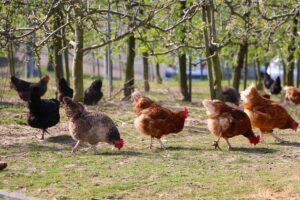
If you’re a backyard farmer or a sustainable living advocate, understanding chicken foraging behavior can be incredibly beneficial. Not only does it provide insights into your flock’s natural instincts, but it also supports a more sustainable lifestyle by allowing chickens to fulfill their nutritional needs naturally. This can increase their health while decreasing their need for feed. Let’s explore the fascinating world of chicken foraging also called free ranging and its many benefits.
Chicken Foraging Behavior
A. Scratching Instincts
Chickens have inherited a remarkable set of behaviors from their jungle fowl ancestors, and scratching is at the heart of it. This instinct helps them find food, stay active, and express their natural behaviors. Keep this in mind before you let them loose in your newly planted garden! Chickens exhibit:
- Evolutionary Development: These habits are rooted in their jungle fowl ancestry.
- Timing Patterns: Chickens scratch throughout the day, with variations and adaptations for different seasons.
- Physical Mechanics: Chickens use their feet, beaks, and wings to scratch up the ground looking for insects, seeds, and other tasty morsels.
- Two-footed Backward Scratch: A unique movement that dislodges insects and seeds.
- Head Positioning and Eye Coordination: Essential for accuracy.
- Depth and Intensity Variations: Adapted to different ground textures, weather, and light conditions.
B. Understanding Foraging Preferences
- Vegetation Types
Different chickens have varying preferences when it comes to their vegetation types. Some may enjoy leafy greens like spinach and kale while others may prefer root vegetables like carrots and turnips. Knowing your flock’s preferences can help you plan your garden or pasture rotation accordingly.
- Shade Availability
Chickens tend to prefer areas with some shade during the hottest parts of the day. This is especially important for breeds with lighter colored feathers that are more susceptible to sunburn.
- Soil Conditions
Soil conditions can also impact the foraging behavior of chickens. Sandy or loose soil is easier for them to scratch through and may lead to more successful foraging.
Benefits of Chicken Foraging
- Nutritional Value:
Allowing your chickens to forage will provide them with a well-rounded diet full of essential nutrients, vitamins, and minerals.
- Natural Exercise:
Scratching and pecking mimic natural chicken behaviors in the wild, providing exercise and keeping your flock active and healthy.
Chickens are great at finding and eating insects, making them a natural form of pest control in gardens and pastures.
- Environmental Health:
Chickens can help improve the soil quality by scratching and aerating the ground, as well as adding nutrients through their droppings.
- Cost Savings:
By allowing your chickens to forage, you can save money on feed costs and provide a more sustainable source of food for your flock.
Tips for Encouraging Foraging
- Provide a covered area or natural shade in the chicken run or pasture.
- Rotate and vary vegetation types in the area where your chickens are foraging.
- Supplement with high-quality feed to ensure proper nutrition.
- Keep an eye out for any poisonous plants or potential hazards in your flock’s foraging area.
Overall, encouraging and allowing your chickens to engage in natural foraging behaviors has many benefits.
C. Pecking Preferences
Chickens have discerning tastes when it comes to their diet. Understanding their preferences can help you provide a more fulfilling environment.
Food Selection:
- Color Discrimination: Bright colors often attract their attention.
- Size Preferences and Texture Choices influence what they peck at.
- Movement Attraction: Chickens are drawn to moving targets like insects.
- Target Priorities include insects and larvae, seeds, tender vegetation, and small stones for digestive aid.
- Learning Patterns: Chickens learn from their peers and their own experience.
- Social Learning from mother hens and flock influences.
- Experience-Based Adaptation for seasonal food availability.
D. Social Dynamics
Foraging in a group setting involves complex social interactions and dynamics.
Hierarchical Feeding:
- Pecking Order Influence on access to the best feeding spots.
- Resource Competition can lead to varied time spent foraging.
- Group Behavior involves sentinel systems, communal feeding, warning signals, and food calling.
- Teaching Behaviors by mother hens influence chick learning and group coordination.
Free-Range Benefits
A. Nutritional Advantages
Free-range chickens benefit from a diverse diet that contributes to their overall health and productivity.
- Natural Diet Diversity includes wild seeds, insect protein, fresh vegetation, and natural minerals.
- Dietary Self-Regulation allows chickens to balance their intake and adapt to seasonal changes.
- Quality Improvements in eggs and meat, better immunity, and reduced feed costs.
B. Exercise Benefits
Foraging provides ample exercise, which is crucial for maintaining healthy chickens.
- Physical Development:
- Muscle Strength, Bone Density, Cardiovascular Health, and Joint Flexibility.
- Activity Patterns include daily movement cycles, energy expenditure, and rest periods.
- Health Impacts such as weight management, digestive efficiency, and respiratory strength.
C. Behavioral Enrichment
Foraging enriches chickens’ lives by offering:
- Mental Stimulation through problem-solving, exploration, and sensory engagement.
- Stress Reduction via natural behavior outlets and social interaction.
- Flock Dynamics improvements in social bonding, communication, and hierarchy establishment.
D. Supplemental Nutrition
Consider seasonal variations and habitat management strategies:
- Seasonal Variations in forage availability.
- Habitat Management through pasture rotation, plant diversity, and soil maintenance.
- Support Systems like supplemental feed, water sources, and shelter.
Management Considerations
A. Space Requirements
Providing sufficient space and suitable terrain is essential for healthy foraging behavior.
- Area per Bird guidelines, optimal range sizes, and recovery periods.
- Terrain Features including vegetation, shade, soil conditions, and drainage.
B. Safety Measures
Ensuring your chickens’ safety while foraging is paramount.
- Predator Protection with secure fencing, overhead coverage, and safe zones. Consider things like chicken tractors, chicken tunnels and other protective options.
- Health Monitoring for parasites, diseases, injuries, and environmental hazards.
In conclusion, unlocking the secrets of chicken foraging behavior can lead to healthier, happier chickens and a more sustainable backyard farming operation. For further guidance and personalized advice, consider consulting with one of our farming specialists or joining a community of like-minded sustainable living advocates.
Start exploring your chickens’ foraging potential today!
Check out my other chicken care articles:
Chicken Foraging and Free Ranging
Best Chicken Breeds for Egg Laying
